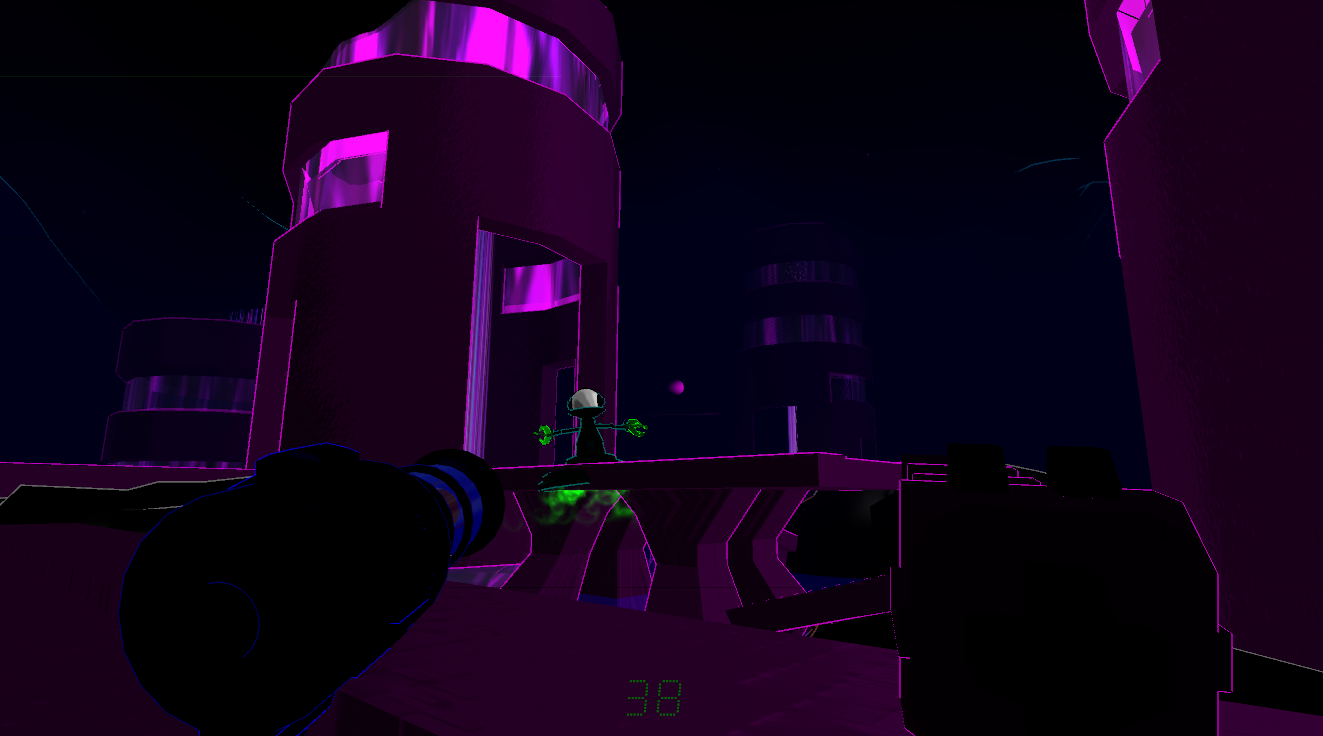 After some hands-on experience with a vintage "Battlezone" machine, I decided to temporarily retreat from realism and experiment with a minimalist faux-vector art style. The vector influence may have been lost along the way, but the end result allowed for a looser playspace, a workable sandbox to refine some fairly ambitious systems. Visually speaking, it's certainly a bit rough, but the bold and highly contrasted look is much easier on the eyes than some of my previous attempts, and the game's surrealist, Jack Kirby-inspired weirdness allowed me to play with some unused creatures from my pixel art years.
After some hands-on experience with a vintage "Battlezone" machine, I decided to temporarily retreat from realism and experiment with a minimalist faux-vector art style. The vector influence may have been lost along the way, but the end result allowed for a looser playspace, a workable sandbox to refine some fairly ambitious systems. Visually speaking, it's certainly a bit rough, but the bold and highly contrasted look is much easier on the eyes than some of my previous attempts, and the game's surrealist, Jack Kirby-inspired weirdness allowed me to play with some unused creatures from my pixel art years. The (extremely simple) gameplay here largely stems from an attempt to expand on the unfinished "Glitch Hunter" random level building, which ended up working surprisingly well here. The abstract feel of the world helps to disguise a lot of the seams, and I'm particularly pleased with the feel of the nerve-like root clusters, an extremely simple bit of code which adds near infinite variety to the world. I also cooked up a fairly decent water system, wherein the neon-colored sea will start to rise once the objective is complete, leading to some (surprisingly) tense scrambles to find an exit before the player inevitably drowns. Honestly, these races against time were far more thrilling than the rather half-assed gunplay, and I'm bound to further revise this concept in the future.
The (extremely simple) gameplay here largely stems from an attempt to expand on the unfinished "Glitch Hunter" random level building, which ended up working surprisingly well here. The abstract feel of the world helps to disguise a lot of the seams, and I'm particularly pleased with the feel of the nerve-like root clusters, an extremely simple bit of code which adds near infinite variety to the world. I also cooked up a fairly decent water system, wherein the neon-colored sea will start to rise once the objective is complete, leading to some (surprisingly) tense scrambles to find an exit before the player inevitably drowns. Honestly, these races against time were far more thrilling than the rather half-assed gunplay, and I'm bound to further revise this concept in the future. As a narrative-minded gamer, I instinctively wanted to attach a story here - but now that it's behind me, I think that it works better as a mysterious abstract sort of piece, perhaps in part due to its arcade-inspired roots. One discarded premise involved a VR program allowing the augmentation of human memories, in which the player would be tasked by an overbearing client to destroy traces of painful conversations. It's the kind of thing which seems novel when first brainstormed, but reveals itself as too esoteric and convoluted when forcibly inserted into the game. In the end I'm glad I exercised the plot completely, as I don't think the addition of text storytelling would have added much.
As a narrative-minded gamer, I instinctively wanted to attach a story here - but now that it's behind me, I think that it works better as a mysterious abstract sort of piece, perhaps in part due to its arcade-inspired roots. One discarded premise involved a VR program allowing the augmentation of human memories, in which the player would be tasked by an overbearing client to destroy traces of painful conversations. It's the kind of thing which seems novel when first brainstormed, but reveals itself as too esoteric and convoluted when forcibly inserted into the game. In the end I'm glad I exercised the plot completely, as I don't think the addition of text storytelling would have added much. While I don't foresee myself going back to fine-tune this (enjoyable) mess, there were certainly some powerful lessons learned over the three weeks I spent playing with it. Namely:
While I don't foresee myself going back to fine-tune this (enjoyable) mess, there were certainly some powerful lessons learned over the three weeks I spent playing with it. Namely:1. Progress on individual systems moves much more quickly in a temporary "jam world" built around those concepts, rather than trying to balance them within an ongoing (and constantly expanding) project.
2. Procedural generation is easier than it might seem, but in this iteration isn't quite ready to craft anything resembling a traditional game level. It does, however, make for some extremely unpredictable on-the-fly playtesting, and is in many ways more informative than using a single pre-made "test arena."
3. An abstract approach makes for good prototyping, for several reasons. Most notably, it helps me curb my perfectionist tendencies and experiment with quickly-made temporary assets. It's easier to work on things that matter (scripts, layouts) when using models that don't require perfect realism.
4. Bright, unsaturated colors hurt the eyes as well as the brain. While the liberal use of black here is quite helpful on that front, use of these neon tones is a bad habit that I'd personally like to shed.
Most importantly, the game jam approach is both inspiring and rewarding, and I look forward to working on similar short experimental pieces (perhaps as part of a more prominent, and team-oriented, jam) before trying my hand at another big project.















No comments:
Post a Comment